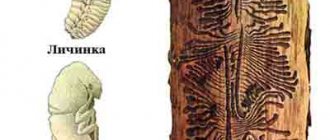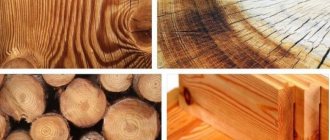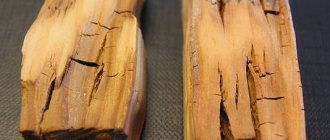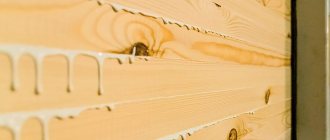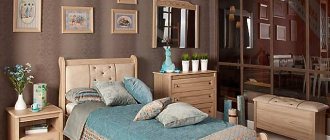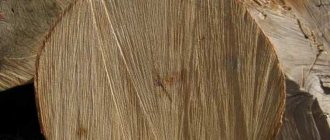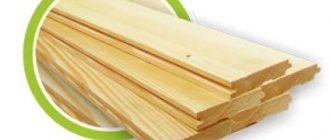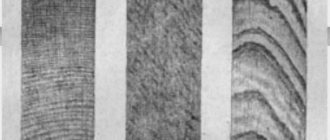Properties of wood
The properties of wood are divided into physical and mechanical. The presence of certain defects in the wood and its resistance to decay are also important.
Physical properties of wood. The main physical properties of wood include humidity, shrinkage, swelling, true and average density, porosity, thermal conductivity, etc.
Wood, having a fibrous structure and high porosity (55 - 65%), has a large internal surface that easily adsorbs moisture from the air. When temperature and humidity operating conditions change, wood easily absorbs and releases moisture, which affects its moisture content. The humidity corresponding to the limiting content of moisture bound by molecular forces in the absence of it in a free state is called the hygroscopic limit of wood or the fiber saturation point.
The hygroscopicity limit of wood is on average 30%.
Humidity affects all physical and mechanical properties of wood (an increase in humidity leads, for example, to an increase in electrical conductivity, an increase in size, and a decrease in strength). Depending on the humidity, wood is divided into: wet
, which has been in water for a long time, with a humidity above 100%;
freshly cut
, humidity 50 - 100%,
air-dry
, stored in air for a long time, humidity 15 - 20%;
room-dry
, humidity 8 - 12% and
absolutely dry
, humidity about 0%.
The moisture content of wood that is kept at constant temperature and humidity conditions for a long time is called equilibrium
.
To obtain comparable data on the physical and mechanical properties of wood, depending on humidity, the concept of standard wood moisture
, the value of which is set equal to 12%.
Shrinkage and swelling
changes in wood occur when its moisture content changes. There are linear and volumetric shrinkage. Linear shrinkage across the fibers is determined in two directions - tangential and radial. Shrinkage in the radial direction is 3-6%, in the tangential direction - 1.5-2 times more than in the radial direction. Shrinkage along the fibers is not determined due to its insignificant value. Volumetric shrinkage averages 12-15%. Shrinkage and swelling occur within the limits of hygroscopicity (0-30%), while the physical and mechanical properties of wood also change (deteriorate). An increase in humidity above 30% has almost no effect on the properties of wood; its volume does not increase due to swelling.
True Density
wood matter of all species is approximately the same and amounts to 1.54 g/cm3.
The average density
varies from 380 kg/m3 (Siberian fir) to 1110 kg/m3 (pistachio kernel). To convert the density of wood with a moisture content of up to 30% to the density at standard humidity, use the formula
,
where is the average density of wood at standard humidity, g/cm3; – average density of wood at a given humidity, g/cm3; k
0 – volumetric shrinkage coefficient, %;
W
– sample humidity, %.
If the volumetric shrinkage coefficient k
0 was not determined, then when recalculating the density to standard moisture content for birch, beech and larch wood, its value is taken equal to 0.6, and for other species - 0.5.
Thermal conductivity
wood, due to its high porosity, is generally low, while the thermal conductivity along the fibers is much greater than across it. For example, the thermal conductivity of pine along the fibers is 0.35 W/(m °C), and across the fibers – 0.17 W/(m °C).
Wood is a flammable material with an ignition temperature of 238-255 °C.
Mechanical properties of wood. The mechanical properties of wood are characterized by compressive strength limits (along and across the fibers), tensile strength, static bending and chipping, and elastic moduli. When testing for strength, samples, as a rule, must have normalized humidity (equilibrium humidity in an environment with a temperature of (20±2) °C and relative air humidity (65±2)%). To do this, before testing, the samples are conditioned at the specified environmental parameters until the wood acquires normalized moisture content. At the same time, the current standard allows testing on samples that have not been conditioned, with humidity different from normal.
The compressive strength along the fibers of conditioned samples is recalculated to a standard humidity of 12% with an error of up to 0.5 MPa according to the formulas:
– for samples with humidity less than the hygroscopic limit (30%)
,
where is the compressive strength of the sample at standard humidity, MPa; is the compressive strength of the sample with humidity W
at the time of testing, MPa;
a
– correction factor equal to 0.04;
W
– sample humidity at the time of testing, %;
– for samples with humidity equal to or greater than the hygroscopic limit,
,
where is the conversion factor at a humidity of 30%, equal to 0.550 - for oak, linden, alder; 0.450 – beech, pine; 0.445 – spruce, aspen, fir, poplar; 0.400 – birch and larch.
Compressive strength of wood across the grain
4-6 times less than the compressive strength along the fibers.
Strength limit of wood under static bending
at a given humidity (in MPa) is determined on samples in the shape of a rectangular prism with a cross section of 20´20 mm and a length along the fibers of 300 mm according to the formula
,
where is the maximum breaking load applied at the center of the sample, N; l
– distance between supports, mm;
b
and
h
– width and height of the sample, mm.
Conversion of the tensile strength of wood during static bending to standard moisture content is carried out in the same way as for the tensile strength during compression.
Tensile strength of wood when chipped along the grain
is small and amounts to approximately 12-25% of the compressive strength along the fibers.
Elastic moduli under compression along the fibers and static bending
approximately the same; for air-dried pine and spruce are in the range of 10,000-15,000 MPa. Their value increases with increasing density, and moistening reduces the value of elastic moduli.
Defects of wood. Wood defects are divided into groups: knots, cracks, trunk shape defects, wood structural defects, chemical stains, fungal lesions and other defects.
Bitches
- parts of branches enclosed in wood. They disrupt the homogeneity of the wood structure, cause bending of the fibers and complicate mechanical processing.
Cracks
(metic, frosty, peeling) - tears in wood along the grain. Violate the integrity of the material, reduce mechanical strength and durability.
Trunk shape defects
.
They are distinguished: taper
- a decrease in the diameter of round timber from the thick to the thin end, exceeding the normal taper (equal to 1 cm per 1 m of log length);
increases wood consumption when sawing, reduces the strength of materials; backbone
- a sharp increase in the butt (lower) part of the trunk;
curvature
, which makes it difficult to mechanically process wood and reduces its tensile and bending strength.
Defects in the structure of wood . Distinguish between: fiber inclination (oblique)
– non-parallelism of wood fibers to the axis of the wood material, reducing its tensile and bending strength;
heel - abnormal thickening of late wood in the annual layers; curliness - fibrous or random arrangement of wood fibers, most often in the butt part of the trunk; curl - a sharp local curvature of the annual layers under the influence of knots and shoots; core - the narrow central part of the trunk, consisting of loose wood tissue, which, when it gets into the products, increases their cracking.
To chemical colors
include yellowness, orange coloring, ink stains, tanning streaks. All of them penetrate to a depth of 1-5 mm and have little effect on the physical and mechanical properties of wood, mainly worsening only the appearance of the lumber.
Fungal infections (rot)
, formed in a growing tree under the influence of wood-destroying fungi, significantly reduce the mechanical properties and grade of wood. Rot of dead wood is one of the most dangerous defects. They are formed under the influence of house mushrooms. Wood becomes not only unsuitable for use, but also dangerous for surrounding materials.
Defects such as mushroom stains
, developing in dead wood, little change its strength, but worsen its appearance.
To other vices
wood includes damage by insects (wormholes), foreign inclusions and defects, deformations (warping - curvature of lumber that occurs during sawing, drying and storage).
Protection of wood from rotting and fire. The main method of protecting wood from rotting and increasing its strength is drying.
.
There are natural and artificial drying. Natural
drying occurs in warehouses - elevated areas with equipped drains and protection from precipitation in the form of canopies.
To prevent rapid drying and cracking, the ends of the boards are coated with a liquid composition of lime, glue, and table salt. The boards are stacked, the top layer is placed at an angle and covered with waterproofing material. Natural drying does not require special equipment, but is carried out slowly, depends on the weather and takes from 2-3 months to 1-1.5 years. Air-dried wood is obtained with a minimum moisture content of 15%. Artificial
drying occurs much faster and allows wood to be dried to a moisture content of 6-10%.
Artificial drying is often carried out in
periodic
chamber dryers in them you can create a soft drying mode and avoid cracking of the wood; The drying time for pine and spruce boards 50 mm thick is 3-6 days. In addition, contact drying
, when thin wood (veneer, plywood) is dried between periodically closing hot press plates;
high-speed drying in hot liquid media
, when the wood in the form of a package is immersed in a bath with a petrolatum solution heated to a temperature of 130 - 140 ° C for 8-12 hours (in this case, the wood does not crack or warp; at the same time it is antiseptic);
drying with high-frequency currents,
when wood is placed between mesh electrodes to which high-frequency current is applied (this type of drying requires a lot of energy and is used only for high-quality wood materials).
For chemical
To protect wood from rotting and damage by insects, special substances are used -
antiseptics.
They are divided into water-soluble and water-insoluble (oily).
Water-soluble
include : sodium fluoride NaF (used in solutions of 2-3% concentration);
sodium fluoride silico Na2SiF6 (used together with sodium fluoride, as well as in antiseptic pastes); preparations CHC (a mixture of zinc chloride and sodium or potassium chromium) and MCCC (a mixture of zinc chloride, chromium and copper sulfate); organosoluble preparations of the PL type (solutions of pentachlorophenol in light petroleum products); highly toxic antiseptics in the form of liquids and pastes containing metal arsenates. Oily
antiseptics - anthracene, shale, creosote oils - have a strong antiseptic effect, do not cause metal corrosion, but paint the wood dark and have a pungent phenolic odor. They are used for processing sleepers, bridge parts, piles, and above-ground wooden structures.
Impregnation with antiseptics is carried out by surface treatment, in hot-cold baths and under pressure in autoclaves.
To protect wood from fire
provide for: appropriate
design
measures (installation of cuttings made of fireproof materials, protective coatings - plaster, etc.);
painting the surface of wood with fire-retardant paint compositions
(compositions of a binder - usually liquid glass, filler - quartz sand, chalk, magnesite and alkali-resistant pigment (ocher, mummies, etc.); impregnation with
fire-retardant substances - fire retardants
(borax, ammonium sulfate, phosphorus -acid sodium and ammonium), which during a fire either form a melted film on the surface of the wood, impeding the access of oxygen, or emit non-flammable gases that reduce the concentration of oxygen in the gaseous environment near the structure.
The properties of wood are divided into physical and mechanical. The presence of certain defects in the wood and its resistance to decay are also important.
Physical properties of wood. The main physical properties of wood include humidity, shrinkage, swelling, true and average density, porosity, thermal conductivity, etc.
Wood, having a fibrous structure and high porosity (55 - 65%), has a large internal surface that easily adsorbs moisture from the air. When temperature and humidity operating conditions change, wood easily absorbs and releases moisture, which affects its moisture content. The humidity corresponding to the limiting content of moisture bound by molecular forces in the absence of it in a free state is called the hygroscopic limit of wood or the fiber saturation point.
The hygroscopicity limit of wood is on average 30%.
Humidity affects all physical and mechanical properties of wood (an increase in humidity leads, for example, to an increase in electrical conductivity, an increase in size, and a decrease in strength). Depending on the humidity, wood is divided into: wet
, which has been in water for a long time, with a humidity above 100%;
freshly cut
, humidity 50 - 100%,
air-dry
, stored in air for a long time, humidity 15 - 20%;
room-dry
, humidity 8 - 12% and
absolutely dry
, humidity about 0%.
The moisture content of wood that is kept at constant temperature and humidity conditions for a long time is called equilibrium
.
To obtain comparable data on the physical and mechanical properties of wood, depending on humidity, the concept of standard wood moisture
, the value of which is set equal to 12%.
Shrinkage and swelling
changes in wood occur when its moisture content changes. There are linear and volumetric shrinkage. Linear shrinkage across the fibers is determined in two directions - tangential and radial. Shrinkage in the radial direction is 3-6%, in the tangential direction - 1.5-2 times more than in the radial direction. Shrinkage along the fibers is not determined due to its insignificant value. Volumetric shrinkage averages 12-15%. Shrinkage and swelling occur within the limits of hygroscopicity (0-30%), while the physical and mechanical properties of wood also change (deteriorate). An increase in humidity above 30% has almost no effect on the properties of wood; its volume does not increase due to swelling.
True Density
wood matter of all species is approximately the same and amounts to 1.54 g/cm3.
The average density
varies from 380 kg/m3 (Siberian fir) to 1110 kg/m3 (pistachio kernel). To convert the density of wood with a moisture content of up to 30% to the density at standard humidity, use the formula
,
where is the average density of wood at standard humidity, g/cm3; – average density of wood at a given humidity, g/cm3; k
0 – volumetric shrinkage coefficient, %;
W
– sample humidity, %.
If the volumetric shrinkage coefficient k
0 was not determined, then when recalculating the density to standard moisture content for birch, beech and larch wood, its value is taken equal to 0.6, and for other species - 0.5.
Thermal conductivity
wood, due to its high porosity, is generally low, while the thermal conductivity along the fibers is much greater than across it. For example, the thermal conductivity of pine along the fibers is 0.35 W/(m °C), and across the fibers – 0.17 W/(m °C).
Wood is a flammable material with an ignition temperature of 238-255 °C.
Mechanical properties of wood. The mechanical properties of wood are characterized by compressive strength limits (along and across the fibers), tensile strength, static bending and chipping, and elastic moduli. When testing for strength, samples, as a rule, must have normalized humidity (equilibrium humidity in an environment with a temperature of (20±2) °C and relative air humidity (65±2)%). To do this, before testing, the samples are conditioned at the specified environmental parameters until the wood acquires normalized moisture content. At the same time, the current standard allows testing on samples that have not been conditioned, with humidity different from normal.
The compressive strength along the fibers of conditioned samples is recalculated to a standard humidity of 12% with an error of up to 0.5 MPa according to the formulas:
– for samples with humidity less than the hygroscopic limit (30%)
,
where is the compressive strength of the sample at standard humidity, MPa; is the compressive strength of the sample with humidity W
at the time of testing, MPa;
a
– correction factor equal to 0.04;
W
– sample humidity at the time of testing, %;
– for samples with humidity equal to or greater than the hygroscopic limit,
,
where is the conversion factor at a humidity of 30%, equal to 0.550 - for oak, linden, alder; 0.450 – beech, pine; 0.445 – spruce, aspen, fir, poplar; 0.400 – birch and larch.
Compressive strength of wood across the grain
4-6 times less than the compressive strength along the fibers.
Strength limit of wood under static bending
at a given humidity (in MPa) is determined on samples in the shape of a rectangular prism with a cross section of 20´20 mm and a length along the fibers of 300 mm according to the formula
,
where is the maximum breaking load applied at the center of the sample, N; l
– distance between supports, mm;
b
and
h
– width and height of the sample, mm.
Conversion of the tensile strength of wood during static bending to standard moisture content is carried out in the same way as for the tensile strength during compression.
Tensile strength of wood when chipped along the grain
is small and amounts to approximately 12-25% of the compressive strength along the fibers.
Elastic moduli under compression along the fibers and static bending
approximately the same; for air-dried pine and spruce are in the range of 10,000-15,000 MPa. Their value increases with increasing density, and moistening reduces the value of elastic moduli.
Defects of wood. Wood defects are divided into groups: knots, cracks, trunk shape defects, wood structural defects, chemical stains, fungal lesions and other defects.
Bitches
- parts of branches enclosed in wood. They disrupt the homogeneity of the wood structure, cause bending of the fibers and complicate mechanical processing.
Cracks
(metic, frosty, peeling) - tears in wood along the grain. Violate the integrity of the material, reduce mechanical strength and durability.
Trunk shape defects
.
They are distinguished: taper
- a decrease in the diameter of round timber from the thick to the thin end, exceeding the normal taper (equal to 1 cm per 1 m of log length);
increases wood consumption when sawing, reduces the strength of materials; backbone
- a sharp increase in the butt (lower) part of the trunk;
curvature
, which makes it difficult to mechanically process wood and reduces its tensile and bending strength.
Defects in the structure of wood . Distinguish between: fiber inclination (oblique)
– non-parallelism of wood fibers to the axis of the wood material, reducing its tensile and bending strength;
heel - abnormal thickening of late wood in the annual layers; curliness - fibrous or random arrangement of wood fibers, most often in the butt part of the trunk; curl - a sharp local curvature of the annual layers under the influence of knots and shoots; core - the narrow central part of the trunk, consisting of loose wood tissue, which, when it gets into the products, increases their cracking.
To chemical colors
include yellowness, orange coloring, ink stains, tanning streaks. All of them penetrate to a depth of 1-5 mm and have little effect on the physical and mechanical properties of wood, mainly worsening only the appearance of the lumber.
Fungal infections (rot)
, formed in a growing tree under the influence of wood-destroying fungi, significantly reduce the mechanical properties and grade of wood. Rot of dead wood is one of the most dangerous defects. They are formed under the influence of house mushrooms. Wood becomes not only unsuitable for use, but also dangerous for surrounding materials.
Defects such as mushroom stains
, developing in dead wood, little change its strength, but worsen its appearance.
To other vices
wood includes damage by insects (wormholes), foreign inclusions and defects, deformations (warping - curvature of lumber that occurs during sawing, drying and storage).
Protection of wood from rotting and fire. The main method of protecting wood from rotting and increasing its strength is drying.
.
There are natural and artificial drying. Natural
drying occurs in warehouses - elevated areas with equipped drains and protection from precipitation in the form of canopies.
To prevent rapid drying and cracking, the ends of the boards are coated with a liquid composition of lime, glue, and table salt. The boards are stacked, the top layer is placed at an angle and covered with waterproofing material. Natural drying does not require special equipment, but is carried out slowly, depends on the weather and takes from 2-3 months to 1-1.5 years. Air-dried wood is obtained with a minimum moisture content of 15%. Artificial
drying occurs much faster and allows wood to be dried to a moisture content of 6-10%.
Artificial drying is often carried out in
periodic
chamber dryers in them you can create a soft drying mode and avoid cracking of the wood; The drying time for pine and spruce boards 50 mm thick is 3-6 days. In addition, contact drying
, when thin wood (veneer, plywood) is dried between periodically closing hot press plates;
high-speed drying in hot liquid media
, when the wood in the form of a package is immersed in a bath with a petrolatum solution heated to a temperature of 130 - 140 ° C for 8-12 hours (in this case, the wood does not crack or warp; at the same time it is antiseptic);
drying with high-frequency currents,
when wood is placed between mesh electrodes to which high-frequency current is applied (this type of drying requires a lot of energy and is used only for high-quality wood materials).
For chemical
To protect wood from rotting and damage by insects, special substances are used -
antiseptics.
They are divided into water-soluble and water-insoluble (oily).
Water-soluble
include : sodium fluoride NaF (used in solutions of 2-3% concentration);
sodium fluoride silico Na2SiF6 (used together with sodium fluoride, as well as in antiseptic pastes); preparations CHC (a mixture of zinc chloride and sodium or potassium chromium) and MCCC (a mixture of zinc chloride, chromium and copper sulfate); organosoluble preparations of the PL type (solutions of pentachlorophenol in light petroleum products); highly toxic antiseptics in the form of liquids and pastes containing metal arsenates. Oily
antiseptics - anthracene, shale, creosote oils - have a strong antiseptic effect, do not cause metal corrosion, but paint the wood dark and have a pungent phenolic odor. They are used for processing sleepers, bridge parts, piles, and above-ground wooden structures.
Impregnation with antiseptics is carried out by surface treatment, in hot-cold baths and under pressure in autoclaves.
To protect wood from fire
provide for: appropriate
design
measures (installation of cuttings made of fireproof materials, protective coatings - plaster, etc.);
painting the surface of wood with fire-retardant paint compositions
(compositions of a binder - usually liquid glass, filler - quartz sand, chalk, magnesite and alkali-resistant pigment (ocher, mummies, etc.); impregnation with
fire-retardant substances - fire retardants
(borax, ammonium sulfate, phosphorus -acid sodium and ammonium), which during a fire either form a melted film on the surface of the wood, impeding the access of oxygen, or emit non-flammable gases that reduce the concentration of oxygen in the gaseous environment near the structure.
Main characteristics of wood as a building material
For restorers, the most important fact is that until recently in Russia, wood was the main and most common building material from which almost everything was made. Among other things, this means that the old masters had vast experience in wood processing, which was lost with the advent of new modern industrial building materials.
Wood is not a fussy building material, but an item made from it cannot be returned to its original state in order to correct any errors found. Therefore, when working with wood, preliminary calculations and design developments for the entire depth of the technological cycle of product processing are of great importance.
A cut at an angle of 45° is called a tangential cut. It has a textured design in the form of cone-shaped lines.
Rice. 5. Tangential cut
Cutting along the grain produces a radial cut that shows parallel lines of grain.
Rice. 6. Radial cut
A cut across the grain essentially presents a textured pattern of growth rings.
Such a cut will be called transverse.
Rice. 7. Cross section
Beneath the bark of a tree is a thin layer of moist plant tissue called the cambium . The wood located under the cambium and making up the bulk of the trunk is called sapwood . In sapwood species it is uniform throughout the entire cross-section of the tree trunk.
Rice. 8. Sapwood
Some tree species have a clearly visible heartwood , often having a darker color.
Sound trees include all conifers (pine, cedar, spruce, yew, larch) and some deciduous trees, such as oak, ash, poplar. The majority of deciduous species are sapwood, or kernel-free: birch, hornbeam, alder, maple, hornbeam.
Rice. 9. Sound wood
The microstructure of wood is formed by wood cells, and the macrostructure is formed by annual rings, heart-shaped vessels, knots, growths, and curls.
